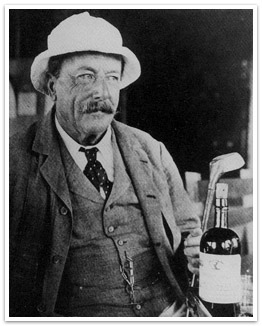
Early Beginnings
The history of modern Japan begins with the Meiji Restoration that ended centuries of isolation, opened Japan’s ports to foreign trade and unleashed a sudden flood of foreigners upon these remote and hitherto forbidden shores. Amongst them was a young Englishman by the name of Arthur Hesketh Groom, who in 1868 disembarked in Kobe to take up residence and seek his fortune.

Although Groom and his contemporaries were restricted with regard to residence and work to Kobe’s Foreign Concession, his love of the outdoors and his fascination with the untamed nature of Mt. Rokko rising 3,054 ft. (931m) almost vertically above the city led him in 1895 to build a cottage near the summit of his beloved mountain. Groom’s retreat was the first of many to follow, and to this day he is acclaimed as having pioneered the development of Mt. Rokko as a resort area and tourist attraction.
Groom’s involvement with Rokko-san didn’t end with his weekend getaways. In 1898 he and a group of like-minded mountaineers, no doubt reminiscing nostalgically about their ancestral home with whisky glass in hand (and perhaps motivated by the establishment of the Royal Hong Kong Golf Club a few years earlier), set about to build a few links on leased land not far from his cottage. After three years of clearing rocks and underbrush without the benefit of modern equipment, by the fall of 1901 they had completed their first four holes.

Word soon spread, and the growing number of golfers prompted the addition of five holes and the official establishment of the Kobe Golf Club on February 27, 1903, with Groom serving as Honorary Secretary and Treasurer and T.C. Thornicraft the Club’s inaugural President. (The latter has the distinction of also being elected the first president of the Kobe Club, another of Kobe’s historical clubs founded by Westerners in the years following the city’s opening to foreign trade.) Another nine holes were added in 1904, resulting in an 18-hole, 3,576 yard, bogey 78 course.
The Original Roll of Members bearing the signatures of 135 members is preserved in the original at the JGA Golf Museum in Hirono, Hyogo Prefecture. With the exception of a sprinkling of Japanese, Germans, Frenchmen and Americans, the founding members were overwhelmingly British nationals who for the most part also belonged to Kobe’s other ‘foreign clubs’, the Kobe Club and the Kobe Regatta & Athletic Club.
Japanese Members
As Japan’s economy grew and the role of the expatriate in business and industry gradually diminished, foreign members began to decline in number and were replaced by Japanese to the extent that in 1926 the latter outnumbered the former by a margin of 98 to 83. Meanwhile, the foreign contingent began to extend to nationals of various countries, and a cosmopolitan atmosphere prevailed both on and off the course.
The dawn of the Showa Era in 1925 saw the completion of a cable car, a ropeway system and a driveway that greatly improve access to Mt. Rokko and led to a boom in resort construction and a further increase in Japanese members, so that by 1933 the latter made up more than 2/3rd of the total. However, management of the Club remained largely in foreign hands.
The War Years

Following the outbreak of the Sino-Japanese War in 1937, Japan’s golf courses were successively confiscated for military purposes or converted into farmland. Due to its location atop Mt. Rokko our Club was initially spared this fate, and records show that club championships were held through 1942. However, with the arrival of occupation forces in 1945 the Club was requisitioned by the US military.
A noteworthy feature of the occupation period was the introduction of bent grass used to over-seed the traditional korai putting surfaces that had replaced the original sand greens in the early 1930’s. The course, which had been largely neglected during the later war years, was gradually restored at the hands of the Americans, and in 1948 all 18 holes were rendered fit for play. The following year the US authorities agreed to open the course to members, and in February 1952 the Club fully reverted to the membership. The first post-war Annual General Meeting was held in April of the same year, and the Club was well on its way to a sound recovery.
The Centennial

Having successfully navigated the twists and turns of what may well be described as Japan’s most tumultuous era, Kobe Golf Club proudly celebrated its centennial by holding its first 100th Anniversary Competition over a four-day period beginning on May 20, 2003. In attendance were representatives of the Japan Golf Association, the presidents of various golf clubs, the UK ambassador to Japan, the captain of the R&A and the chairman of the British Golf Association. The opening ceremony featured the governor of Hyogo teeing off at the 1st hole with a hickory-shafted club and playing a replica gutta percha ball. The competition was followed by a reception held in the clubhouse, and in the tradition of Groom and his fellow mountaineers a good time was had by all.




